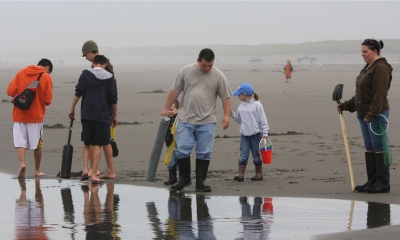
Columbia Zone
Shellfish regulations only apply to Columbia River downstream of Tongue Point/Rocky Point line at the mouth of the Columbia River.

For your safety, call the Oregon Department of Agriculture Shellfish Safety Hotline before harvesting any shellfish at 1-800-448-2474 or check their website.
Regulation Highlights
For additional regulations, consult the e-regulations. Always consult the latest Recreation Report before you go for any in-season closures.
Razor clams
- Daily limit of first 15 dug (no sorting or releasing).
- Razor clams may be taken by hand, shovel, clam gun or tube with opening no less than 4” (cylindrical) or 4” X 3” (elliptical).
- Razor clams are closed Jul 15 to Sep 30 north of Tillamook Head (Clatsop County) for annual conservation closure.
- Before heading out, always check the weekly Recreation Report to see which areas of the coast are currently open or closed for razor clamming.
Dungeness crab
- Daily limit of 12 (males only).
- Minimum size of 5 ¾ inches. Correct size is measured as a straight line across the back (caliper measurement) in front of, but not including the points.
- Bays, beaches, estuaries, tide pools, piers and jetties are open for crabbing all year, 24 hours per day.
- Ocean waters are closed for crab Oct 16 – Nov 30.
- May be taken using crab rings, baited lines, or pots (limited to 3 rings/lines/pots total, per person); by hand, dip net, or rake.
European green crab
- Daily limit of 35 of any size or sex.
- Bay, beaches, estuaries, tide pools, piers and jetties are open for crabbing all year, 24 hours per day.
- Ocean waters are closed for crab Oct 16-Nov 30.
- May be taken using crab rings, baited lines, or pots (limited to 3 rings/lines/pots total, per person); by hand, dip net, or rake.
- Identified by five spines on the outside of each eye, with three bumps between the eyes.
Crabbing in the Columbia zone
Dungeness crab are prevalent in the mouth of the Columbia. The ocean and Columbia River commercial crab fishery is considered the most valuable single-species commercial fishery in Oregon, harvesting a long-term average (25 years) of 14 million pounds of crab per season.
Razor clamming in the Columbia zone
Razor clams are found throughout Oregon’s ocean beaches, including in the mouth of the Columbia River.



